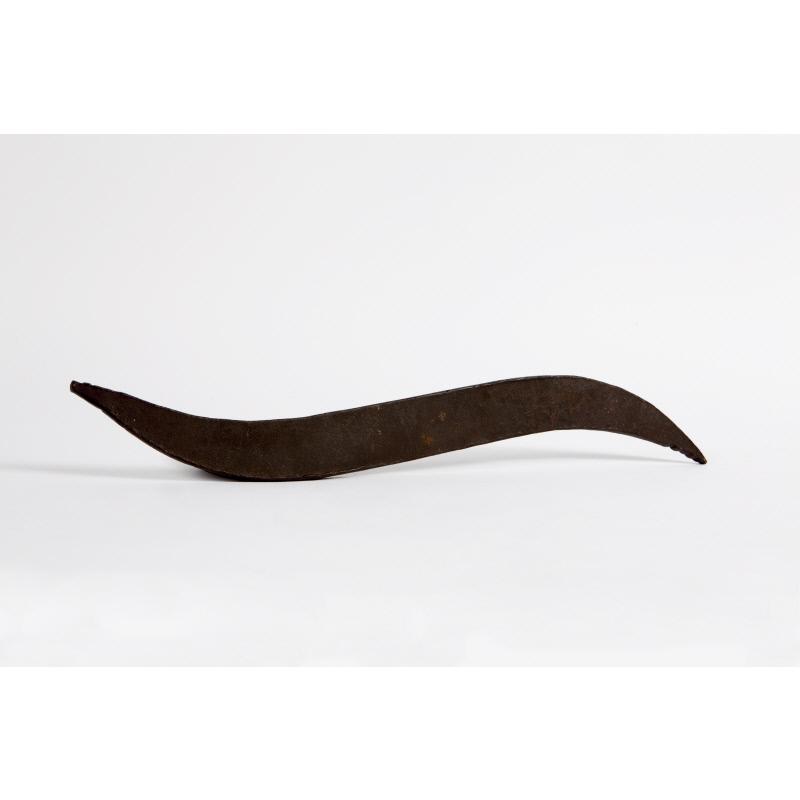
Tyre iron
Collection:David Usborne Collection
Classification(s):
Professional Trades
Recreation
Recreation
Dimensions:
644x38mm
Object number: DU_742
See Also
ProvenanceThis object, part of The David Usborne Collection, was donated to University of the Arts London on 22nd June 2015 by private collector David Usborne. David has been a collector of utilitarian objects for over 30 years. David previously taught design at the Central School of Art & Crafts, now Central Saint Martins, and the collection was originally conceived as an inspiring resource for students. Over time, it has evolved into a unique and idiosyncratic collection of twentieth century tools.
There are over 500 objects, apparatus and instruments which represent a broad range of disciplines and geographies. The objects chosen are based on David’s self-imposed criteria.
David has a magpie approach to collecting. He is drawn to objects where the function is not always decipherable, some objects have a surreal quality or anthropomorphic form, while others are individual components of larger structures or systems. David favours functional and anonymous design over decorative or artistic objects.
Often inexpensive, material was originally purchased from car boot sales, auctions and second-hand shops.
The collection is currently stored at the Archives & Special Collections Centre, London College of Communication. However part of the collection remains in David’s possession at his homes in London and Lisbon. David no longer actively collects, but he does make infrequent purchases.
At the time of donation, David provided rudimentary cataloguing data detailing object attributions (if known) and place and method of acquisition.
David published a related book in 2010, ‘Objectivity: a designer’s book of curious tools’. The book illustrates objects in the collection and features a forward by British designer Thomas Heatherwick. David’s relationship with Heatherwick began in 2004 after David saw an exhibition curated by Heatherwick at the Design Museum, ‘Conran Foundation Collection: Thomas Heatherwick’. Recognising synergies in taste and curatorial approach, David invited the designer to view his collection. Publisher Thames & Hudson introduced a classification system based on function. Each of the nine chapters represent a different classification term including: hitting, cutting, gripping, holding, rubbing, shielding, moulding, spreading and testing. However it is worth noting that this arrangement does not reflect David’s original ordering. Photographer Celine Marchbank produced object photography for the book, the same images are used by University of the Arts London within The Museum System database and eMuseum website.
David created an associated website for the collection, www.object-ivity.com. The website features a gallery of object images which can be sorted according to function, context or metaphor. The website encourages visitors to guess the identity of each object, before revealing a caption. The website notes that the attributions with the captions are David’s best assumption only.
There are over 500 objects, apparatus and instruments which represent a broad range of disciplines and geographies. The objects chosen are based on David’s self-imposed criteria.
David has a magpie approach to collecting. He is drawn to objects where the function is not always decipherable, some objects have a surreal quality or anthropomorphic form, while others are individual components of larger structures or systems. David favours functional and anonymous design over decorative or artistic objects.
Often inexpensive, material was originally purchased from car boot sales, auctions and second-hand shops.
The collection is currently stored at the Archives & Special Collections Centre, London College of Communication. However part of the collection remains in David’s possession at his homes in London and Lisbon. David no longer actively collects, but he does make infrequent purchases.
At the time of donation, David provided rudimentary cataloguing data detailing object attributions (if known) and place and method of acquisition.
David published a related book in 2010, ‘Objectivity: a designer’s book of curious tools’. The book illustrates objects in the collection and features a forward by British designer Thomas Heatherwick. David’s relationship with Heatherwick began in 2004 after David saw an exhibition curated by Heatherwick at the Design Museum, ‘Conran Foundation Collection: Thomas Heatherwick’. Recognising synergies in taste and curatorial approach, David invited the designer to view his collection. Publisher Thames & Hudson introduced a classification system based on function. Each of the nine chapters represent a different classification term including: hitting, cutting, gripping, holding, rubbing, shielding, moulding, spreading and testing. However it is worth noting that this arrangement does not reflect David’s original ordering. Photographer Celine Marchbank produced object photography for the book, the same images are used by University of the Arts London within The Museum System database and eMuseum website.
David created an associated website for the collection, www.object-ivity.com. The website features a gallery of object images which can be sorted according to function, context or metaphor. The website encourages visitors to guess the identity of each object, before revealing a caption. The website notes that the attributions with the captions are David’s best assumption only.
Published References
Objectivity: A designer's book of curious tools, David Usborne, Thames & Hudson, 2010
http://object-ivity.com/
